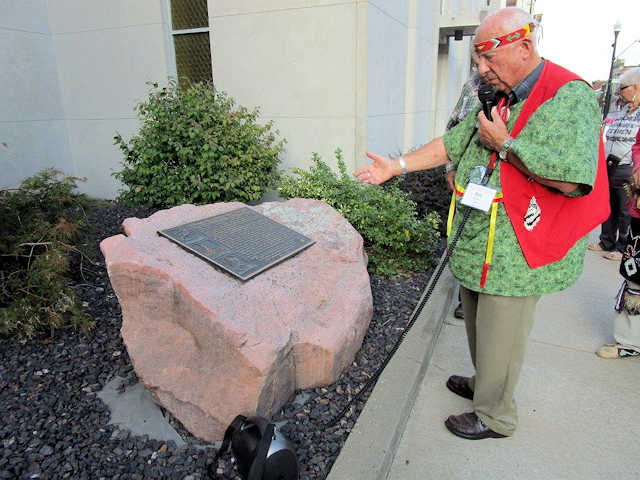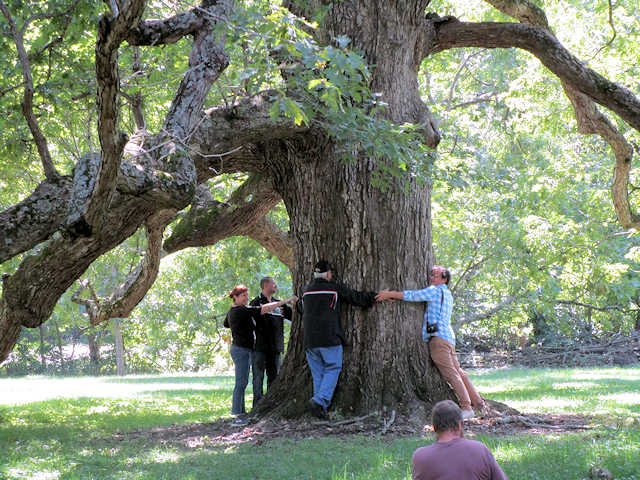| Trail of Death Caravan Across Illinois By Shirley Willard, Fulton County Historian |
  Led by Rich Meyer, Elkhart, our caravan crossed into Illinois Sep 18 at 11 a.m., driving past the Trail of Death historic highway sign at Turtle Run golf course. We ate lunch at Danville in Charlotte’s Restaurant. This restaurant is owned by Ryan Quick, grandson of Paul Quick, who erected the Trail of Death marker at Ellsworth Park in 1993. It is a lovely little restaurant with outside seating and blooming flower bushes. As we traveled Peggy King Anderson read sections from her book “Two-Moon Journey” which is about a little girl on the 1838 Trail of Death. Also Rich Meyer read the diary written by Jesse C. Douglas while he was on the 1838 emigration, not yet called the Trail of Death. We tried to stay together but some got behind and needed help to find the caravan. Some had to make “cornfield stops” when we were not close to restrooms. Carmelita Wamego Skeeter’s grandson, Chris Osborn, was in the last car and would tell us when it made the turns and then say “Quack quack” because he was the tail end. We passed Trail of Death historical markers at Catlin, Sidney, Sidorus, and Monticello. At Decatur we visited Mueller Park and talked to Millikin University people. We also met Dale J. Travis, Decatur, our volunteer webmaster, who has posted the map and all our photos, travels and more on our website www.potawatomi-tda.org. We had dinner with MU students, faculty and staff, generously catered by the Office of Inclusion and Student Engagement. On Sep 19 we drove by the Niantic Trail of Death marker, and walked around the Old State Capitol plaza in Springfield. We had lunch at Subway in New Berlin. Robert Hitt’s tree farm has a huge oak tree that is so big it takes six people holding hands to reach around it. That tree was there in 1838 when the Potawatomi went by. Jacksonville has changed its downtown public square since the last time we were there five years ago. It no longer has the sunken amphitheater. We drove by the Trail of Death sign at Exeter, wet our feet in the Illinois River at Naples, and visited the Mountain family at Perry, Illinois. This family had Potawatomi ancestors and erected the historical marker at Perry. They had attached a metal plaque to a stone “mountain” made of cement and stones. But the stones are falling off so they said they will get a boulder to replace it. We encourage people to use real boulders, about four feet tall, for markers because boulders are the most nearly permanent things on earth. We drove by the Trail of Death marker at Liberty and at Mill Creek by the stone quarry. Local people told us they will move the marker at the stone quarry so it can be seen more easily. Our next stop was St. Boniface Church, Quincy. A huge boulder with large metal plaque was erected there by the Pearl/Slavin family in 1995. Jerry Pearl had hauled a huge red rock from his farm at St Marys, Kansas. Jerry fell down steps recently, breaking several bones and is in a hospital. John Gephardt led us through Mounds State Park to see the Trail of Death sign. He and his group, Friends of the Log Cabin Village, hosted a potluck supper for us at Quinsippi Island Park. The Mayor of Quincy, Kyle Moore, gave us a proclamation declaring Sep 19 as Potawatomi Day. The proclamation was presented to George Godfrey, who passed it on to Shirley Willard, to place in the Fulton County Museum, Rochester, Indiana, the official repository for Potawatomi Trail of Death Association. |
| < Previous | Home | Next > |